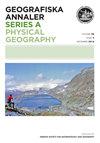太白山西侧晚第四纪景观演化速率的霜冻风化控制——以被动边缘景观演化为例
IF 1.8
4区 地球科学
Q3 GEOGRAPHY, PHYSICAL
Geografiska Annaler Series A-Physical Geography
Pub Date : 2022-10-02
DOI:10.1080/04353676.2022.2121998
引用次数: 0
摘要
被动大陆边缘可以表现出异常高的地形,并表现出从边缘的外部到内部的离散陡峭的悬崖,分裂和平缓的斜坡。与活动(即收敛和走滑)构造区相比,构造不活动(被动)大陆边缘由构造和/或气候驱动的高海拔景观的过程和变化率知之甚少。我们利用在17个流域和12个子流域收集的10Be流域河流砂(n = 29)的剥蚀率,以及地形分析,量化了太白山脉西侧的景观变化率。剥蚀速率范围为~ 20 ~ ~ 70 mm/ka。这些速率在上游和下游地区之间没有显着差异,这意味着剥蚀没有(或只是可以忽略不计)受到深层大量浪费过程和人类影响。TMR北部的剥蚀率是南部的1.6倍。此外,剥蚀速率与地貌参数值的关系也存在南北差异。这些观测到的剥蚀速率和地貌响应的空间差异可以用强烈的霜冻风化而不是岩性控制来解释。我们对剥蚀率和地形的定量分析表明,山脉的主分水岭发生了向西南方向的迁移,山脉的西翼(低起伏)可能处于准平衡的地貌状态,而东翼(陡起伏)仍然是短暂的。本文章由计算机程序翻译,如有差异,请以英文原文为准。
Frost-weathering control on the rate of late Quaternary landscape evolution, western flank of the Taebaek Mountain Range, Korea: a case of passive margin landscape evolution
ABSTRACT Passive continental margins can show anomalously high topography and exhibit a discrete steep escarpment, divide, and gentle slope from the exterior to the interior of the margin. Compared with active (i.e. convergent and strike-slip) tectonic regions, the processes and rates of change of high-altitude landscapes driven by tectonics and/or climate in tectonically inactive (passive) continental margins are poorly understood. We used 10Be catchment-wide denudation rates of fluvial sands (n = 29) collected in 17 catchments and 12 sub-catchments, as well as topographic analysis, to quantify the rate of landscape change along the western flank of the Taebaek Mountain Range (TMR). The denudation rates range from ∼20 to ∼70 mm/ka. These rates show no significant difference between upstream and downstream areas, implying that denudation is not (or is only negligibly) affected by deep-seated mass wasting processes and human impact. 10Be denudation rates in the northern TMR are 1.6 times higher than in the south. In addition, the relationship between denudation rates and geomorphic parameter values also differs from north to south. These observed spatial differences in the rate of denudation and geomorphic response can be explained by intense frost weathering rather than lithological control. Our quantitative analysis of denudation rates and topography suggests that southwest-directed migration of the range’s main divide occurs and that the range's western flank (low relief) is likely to be in a geomorphic state of quasi-equilibrium whereas the eastern flank (steep) still remains transient.
求助全文
通过发布文献求助,成功后即可免费获取论文全文。
去求助
来源期刊
CiteScore
3.60
自引率
0.00%
发文量
12
审稿时长
>12 weeks
期刊介绍:
Geografiska Annaler: Series A, Physical Geography publishes original research in the field of Physical Geography with special emphasis on cold regions/high latitude, high altitude processes, landforms and environmental change, past, present and future.
The journal primarily promotes dissemination of regular research by publishing research-based articles. The journal also publishes thematic issues where collections of articles around a specific themes are gathered. Such themes are determined by the Editors upon request. Finally the journal wishes to promote knowledge and understanding of topics in Physical Geography, their origin, development and current standing through invited review articles.

 求助内容:
求助内容: 应助结果提醒方式:
应助结果提醒方式:


